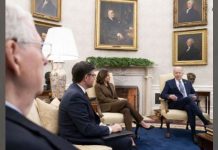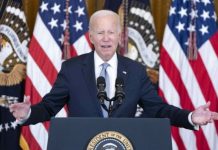
June 17 (UPI) — The 26-month saga that morphed slowly into perhaps the greatest political catastrophe in American history — and saw the only resignation ever of a United States president — grew out of a small Washington, D.C., office suite exactly 45 years ago Saturday.
Just after midnight on June 17, 1972, five burglars were caught red-handed by plainclothes D.C. policemen in the offices of the Democratic National Committee. When they were arrested, the middle-aged, suit-clad bandits held sophisticated communications and surveillance electronics, as well as large amounts of cash.
The building in northwest Washington that held the DNC’s national headquarters was the relatively new Watergate office and hotel complex.
Although virtually no one knew it at the time, the seemingly small-time burglary started a ticking time bomb that ultimately exploded the presidency of Richard M. Nixon.
The Break-In
The five burglars — James McCord, Virgilio González, Bernard Barker, Eugenio Martínez and Frank Sturgis — forced their way into the Watergate complex and DNC offices around midnight on the 16th to replace failing bugging equipment that had been installed there two weeks earlier. The goal was to eavesdrop on the Democrats and collect information that could be used against the party for political purposes.
Police were alerted to the break-in by Watergate security guard Frank Wills, who twice noticed that a lock on one of the doors at the complex had been taped open. Two plainclothes officers in the vicinity responded to the call and, after spending several terse minutes searching the suite, busted the burglars crouching in one of the offices.
“They had to run and hide like rats,” retired Washington, D.C., Metro Police officer John Barrett, one of three arresting officers that night, told ABC News’ 20/20 Friday. “What’s running through my mind is, ‘If there is anybody here, they’re here [in the DNC suite].’
“I was startled by an arm hitting next to the glass on [a] partition. It scared the living bejesus out of me. I screamed something to the effect of, “Come out with your hands up or I will blow your head off.’ Ten hands went up.”
“I don’t think I’ve ever locked up another burglar who was dressed in a suit and tie and was in middle age,” retired D.C. Metro Police Sgt. Paul Leeper said.
At first, the burglary attracted little attention, as the bandits weren’t known to anyone and their motives were uncertain. The first inkling of a possible connection to the Nixon White House was only recognized later at their initial court appearance, and in a mysterious entry — denoting “H. Hunt — W. House” — in one of the men’s address books.
The Cover-Up
What followed the break-in was a slow trickle of information about who the burglars were, what they were doing at the DNC and if there was any connection to the government. Newbie Washington Post reporters Bob Woodward and Carl Bernstein were handed the story by the newspaper’s city desk and expected to cover what was perceived to be a local-level crime with little relevance.
They couldn’t have been further from the truth.
“The question was who was H. Hunt?” Bernstein said.
In short order, Woodward and Bernstein learned that he was E. Howard Hunt, a former CIA operative and Nixon assistant.
“I called the White House and eventually got Hunt on the phone and just asked, ‘Why was your name in the address books of two of these burglars?'” Woodward recalled. “He screamed out, “Good God,’ slammed down the phone and left town.”
Within weeks, the reporters had followed a money trail from the burglars straight to the White House by way of Nixon’s re-election committee. By the time they had blown the story open, every news outlet in the country was latched onto the story.
Ron Ziegler, Nixon’s press officer, lambasted the Post as “shabby” and famously called the Watergate incident “a third-rate burglary.” The president himself responded privately to Woodward’s and Bernstein’s reporting by saying he wanted the Post barred from ever entering the White House again.
The now-legendary efforts of Woodward and Bernstein — which were directed by shadowy FBI whistleblower W. Mark Felt — exposed a long and winding road that was littered with crime, corruption and concealment. The entire ordeal was famously translated to the screen in the Oscar-winning All The President’s Men, starring Robert Redford and Dustin Hoffman as the determined Post reporters.
It was later learned that Hunt and G. Gordon Liddy, finance counsel for the Committee for the Re-election of the President (CRP), were also involved in the break-in as operators of an executive-level “dirty tricks” campaign to ensure Nixon’s success in that November’s election.
“A federal judge named John J. Sirica, who presided over the trial of the burglars, had read the stories, and no fool,” ABC News reporter Sam Donaldson, who covered the Watergate investigation, recalled of the times. “He concluded that these five burglars were on a political mission — looking for what and ordered by whom?”
All five burglars, Hunt and Liddy were indicted by a grand jury on federal burglary, conspiracy and wiretapping charges, and were ultimately sent to prison.
The End
A year after the break-in, President Nixon had settled firmly into the sights of Senate investigators looking to get to the bottom of the Watergate scandal. A special Senate committee began to hold hearings in May 1973 that were broadcast nationally, and quickly became a media sensation.
The Senate panel called a number of witnesses to testify — including top administration aides like senior advisers H.R. Haldeman, John Ehrlichman and John Dean, Attorney General John Mitchell and Nixon assistant Alexander Butterfield.
Perhaps the most surprising revelation that emerged from the hearings was the acknowledgement of listening devices and a taping system in the Oval Office, which were confirmed by Butterfield in his appearance before the committee. The existence of such a taping system set off a protracted legal battle between federal courts and the president.
After losing his fight to keep the tapes private, Nixon eventually handed them over to special investigators who discovered an 18 and-a-half minute gap on one of the tapes, which audio experts later said had been deliberately erased. To this day, no one knows what was erased, but most believe it was some type of incriminating evidence spoken by someone in the Oval Office — mainly because it occurred at a portion of the tape where the Watergate investigation was being discussed.
Ultimately, the tapes provided incontrovertible evidence that Nixon at one point attempted to obstruct justice by asking to use the CIA to shut down the FBI’s Watergate investigation. Months later, Nixon brought even more trouble upon himself when he ordered the firing of special Watergate investigator Archibald Cox — presumably to get the heat off him.
“After the foiled break-in, President Nixon didn’t just participate in but was at the top of the cover-up,” NYU historian Timothy Naftali said Friday. “The goal of that cover-up was to prevent FBI investigators and federal prosecutors from figuring out that the White House had been involved in setting up political espionage operation.”
The president’s order touched off the “Saturday Night Massacre,” when both Attorney General Elliot Richardson and Deputy Attorney General William Ruckelshaus refused the president’s demand to fire Cox and instead resigned themselves. Solicitor General Robert Bork, who would later receive an unsuccessful Supreme Court appointment from President Ronald Reagan, completed Nixon’s order by dismissing Cox.
At this point, public opinion began to turn sharply against Nixon. The House Judiciary Committee voted to impeach the president in late July 1974, and a couple weeks later “the smoking gun” audio tape emerged detailing Nixon’s attempt to shut down the FBI investigation.
Another tape revealed a conversation between Nixon and Dean in which the adviser warned of a growing “cancer on the presidency.” By early August 1974, Nixon had lost the last remaining vestiges of Republican support — and realizing that there was no way to survive the continually growing scandal, he resigned on Aug. 8.
Still Scandalous After 45 Years
Several reunions or events are scheduled Saturday to commemorate the 45th anniversary of the Watergate break-in.
“What was important about Watergate, however long it took, it eventually got to the truth,” North Carolina attorney David Erdman, a Senate committee investigator during the 1973 hearings, now 84, said Friday. “The goal is to … follow the paths wherever they lead.”
The Watergate Hotel is even commemorating the anniversary by announcing plans to turn one of its guest rooms into an exhibit — Scandal Room 214, where Liddy and Hunt staged themselves on the night of the break-in.
“The Watergate Hotel has been a household name with a scandalous past that can’t be ignored,” hotel co-owner Rakel Cohen said. “Everyone kept asking us about room 214, so we needed to do something bold with it.”
Room 214 will be designed and curated by Hollywood costume designer Lyn Paolo.
Naftali said although 45 years have passed since the start of Watergate, the two-year saga continues to be relevant even in today’s different political climate.
“When Nixon got frustrated that the bureaucracy did not implement what he wanted, his demands got irrational and impetuous,” he said. “He doubled down, which led to things like an illegal investigation of Jewish Americans in the labor department.
“So the student of presidential activity has to ask: What happens when a president gets frustrated? What happens when he doesn’t get his way? What can happen is abuse of power.”





